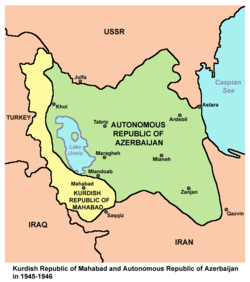أزمة إيران 1946
| أزمة إيران 1946 | |||||||
|---|---|---|---|---|---|---|---|
| جزء من الحرب الباردة | |||||||
 Jafar Pishevari in 1946 | |||||||
| |||||||
| المتحاربون | |||||||
|
|
| ||||||
| القادة والزعماء | |||||||
|
|
| ||||||
| القوى | |||||||
| الجيش الإيراني |
ميليشيات آذرية
| ||||||
| الضحايا والخسائر | |||||||
|
Unknown | غير معروفة | ||||||
| Total: 2,000 killed[2] | |||||||


{{Campaignbox |name = حملات الانفصالية الكردية في إيران |title = الانفصالية الكردية في إيران |listclass = hlist | state = uncollapsed
|battles = 1918–1945
1945–1979
1979–الحاضر
- تمرد 1979
- تمرد الحزب الديمقراطي الكردستاني
- الاحتجاجات الكردية، فبراير 1999
- تمرد حزب الحياة الحرة الكردستاني
- شغب مهاباد
- اشتباكات غرب إيران 2016–الحاضر
- هجوم حزب العمال الكردستاني 2018
- الهجمات على كردستان العراق سبتمبر-أكتوبر 2022
- هجوم أربيل 2024
أزمة إيران 1946، وتُعرف أيضاً بإسم الأزمة الإيرانية الأذربيجانية (فارسية: غائله آذربایجان Qaʾilih Âzarbâyjân, "Azerbaijan crisis"), followed the end of World War II and stemmed from the Soviet Union's refusal to relinquish occupied Iranian territory, despite repeated assurances. In 1941, Iran had been jointly invaded and occupied by the Allied powers of the Soviet Red Army in the north and by the British in the centre and south. Iran was used by the Americans and the British as a transportation route to provide vital supplies to the Soviet Union's war efforts.
As of August 1941, the United States was a neutral nation and had not yet entered as a belligerent in World War II. Therefore, the bloc known as 'The Allies' were principally (with Poland and France occupied by Germany in 1939 and 1940, respectively) the United Kingdom and the Soviet Union, recently forming their alliance after the German invasion of territories of the Western Soviet Union in June 1941. In the aftermath of the occupation of Iran, those Allied forces agreed to withdraw from Iran within six months after the cessation of hostilities. However, when this deadline came in early 1946, the Soviets, under Joseph Stalin, remained in Iran and local pro-Soviet Iranians proclaimed a separatist People's Republic of Azerbaijan.[4]
في أواخر 1945، بالاضافة إلى جمهورية أذربيجان الشعبية، وُلِدت جمهورية مها آباد. وسرعان ما دخل تحالف القوات الكردية والأذربيجانية الشعبية، المدعوم بالسلام والتدريب من الاتحاد السوڤيتي، في قتال مع القوات الإيرانية،[1] مما أسفر عن خسائر إجمالية تناهز 2,000 شخصاً. المفاوضات التي قام بها رئيس الوزراء الإيراني أحمد قوام والضغط الدبلوماسي على السوفيت من الولايات المتحدة أدى في آخر الأمر إلى انسحاب السوفيت. الأزمة تـُرى كواحدة من أوائل النزاعات في الحرب الباردة البازغة آنئذ.
. . . . . . . . . . . . . . . . . . . . . . . . . . . . . . . . . . . . . . . . . . . . . . . . . . . . . . . . . . . . . . . . . . . . . . . . . . . . . . . . . . . . . . . . . . . . . . . . . . . . . . . . . . . . . . . . . . . . . . . . . . . . . . . . . . . . . . . . . . . . . . . . . . . . . . . . . . . . . . . . . . . . . . . .
أزمة إيران 1946
الخلفية
جمهورية آذربيجان الشعبية
جمهورية مهاباد الكردية
الضغط والدعم الدبلوماسي
الحرب الباردة
انظر أيضاً
- Persian Socialist Soviet Republic
- List of modern conflicts in the Middle East
- Kurdish independence movement in Iran
الهامش
للاستزادة
- André Fontaine, La guerre froide 1917–1991, Edestermann: "Kurdish Independence and Russian Expansion", Foreign Affairs, Vol. 24, 1945–1946, pp. 675–686
- George Lenczowski, Russia and the West in Iran (1949)
وصلات خارجية
- مقالات ذات عبارات بحاجة لمصادر
- Articles containing فارسية-language text
- Articles with hatnote templates targeting a nonexistent page
- 1946 في إيران
- 1947 في إيران
- نزاعات الحرب الباردة
- تاريخ الحرب الباردة في إيران
- العلاقات الإيرانية السوڤيتية
- العلاقات الأمريكية السوڤيتية
- 1946 في الاتحاد السوڤيتي
- 1946 في العلاقات الدولية
- 1947 في العلاقات الدولية
- نزاعات 1946
- تمردات في إيران
- حروب أهلية إيرانية
- حروب إيران
- حروب الاتحاد السوڤيتي
- حروب أذربيجان
- العلاقات الأذربيجانية الإيرانية
- التمردات الكردية في إيران
- حروب بالوكالة
